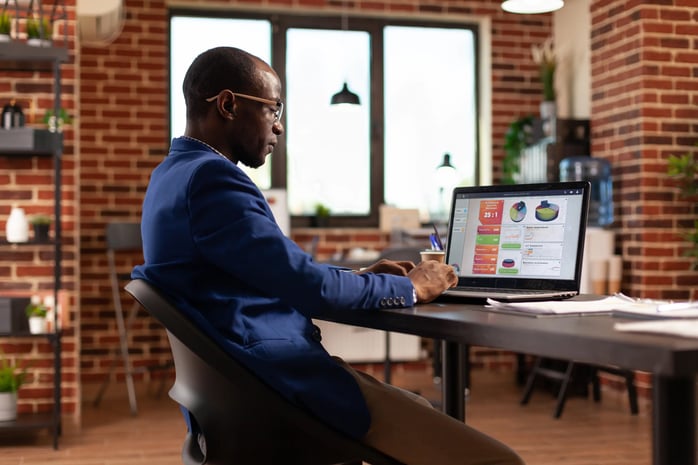Applying Remote Work Lessons to Alumni Engagement: The Importance of Personal Connection
How alumni communities can thrive with an emphasis on personal connections and a selection of strategies for creating meaningful interactions.
Read more
Bringing former employees back into the company fold doesn't have to be a challenge if you follow these simple steps for the best reboarding experience.
In today’s dynamic job market it is increasingly common for employers to hire “boomerang employees”, employees who after leaving the company, choose to return at a later stage in their career. People are no longer staying at one company forever, and the employee lifecycle has changed. There are many benefits to opening your doors for former employees to return, as you gain skilled workers who are already familiar with your organization, work culture and product. Boomerang employees come back highly motivated and are increasingly worth investing in.
Using an alumni network to stay in touch with and bring back former employees is already a great start. But once you have found the perfect candidate and you’re bringing them back into the company fold, you need to make sure you have the set up in place to successfully reboard them. While looking at best employee onboarding experiences when building your reboarding strategy can be helpful, there are several things you should do differently to regular onboarding, to ensure your former employees integrate seamlessly back into your organization. When done properly, reboarding boomerang employees will help boost productivity, company culture and employee retention.

Reboarding is the employee onboarding process of reintegrating former employees into an organization, helping them smoothly transition back into their roles after some time away, and ensuring they are up to date with any changes or developments within the company since their departure. When looking at the stats we can see that 28% of New Hires are Actually Boomerang Employees, which means having a reboarding strategy in place is crucial.
Creating the best employee onboarding experiences for returning employees serves several key goals. It aims to ensure a smooth reintegration, update knowledge and skills, boost productivity, and enhance job satisfaction. By efficiently familiarizing returning employees with the organization's changes and values, the employee onboarding program helps former employees settle back into past jobs faster.
An employee onboarding process is the initial orientation and integration of new employees into the company culture and workflow. Employee onboarding focuses on providing new hires with the knowledge and tools they need to excel in their roles. The main goal is to create a positive first impression for new team members, and foster engagement and retention from day one.
Reboarding, alternatively, is the process of reintegrating former employees who are returning to the organization. It aims to update their skills, refresh their understanding of company culture and ensure they are aligned with any changes or developments since their departure. The main goal here is to minimize disruptions during their return and help them quickly regain productivity.
There are many reasons why an organization might want to reboard previous employees, including to fill a talent gap, seasonal hires or the need for a specific expertise. An employee onboarding program is typically used for new hires, ensuring they become effective team members. Reboarding is for when a previous employee returns as a new hire, helping them adapt to any changes.

The employee onboarding experience is crucial as it ensures a smooth transition for your new hires, and reboarding boomerang employees is just as important. Helping your returning staff quickly regain their productivity and re acquaint themselves with any company changes is crucial in them adapting quickly back into their role. It helps them regain their connection to the organization's culture and values and ultimately boost job satisfaction and company loyalty.
Whilst employee onboarding processes are crucial for helping new employees to fit in and do their job smoothly, reboarding processes offer the same to boomerang employees. A successful reboarding strategy will ultimately save your organization time and resources that would otherwise be spent on extensive training for new hires. It uses the expertise and experience of returning employees and helps improve the company's performance and growth. Ultimately, reboarding is a win-win strategy, promoting employee engagement, reducing turnover, and enhancing the organization's overall effectiveness in utilizing its talent pool.

A well-structured reboarding strategy benefits organizational growth and sustainability. It fosters a strong talent pipeline, enhances employee engagement and morale. When the re-onboarding process is carried out correctly, returning employees tend to feel valued and supported, resulting in higher job satisfaction. This, in turn, boosts productivity and reduces the risk of turnover.
An onboarding program specifically for boomerang employees ensures swift reintegration into the company culture. It minimizes the learning curve for returning employees, helping them adapt to changes and developments more rapidly, which is critical in today's fast-paced business environment.
Reboarding is highly cost-effective when compared to hiring a new employee. It saves on recruitment and hiring costs, and can also reduce the need for extensive onboarding programs and training programs.
A robust reboarding strategy not only sustains organizational knowledge but also drives engagement, cultural alignment, and cost-efficiency, making it an indispensable asset for any forward-thinking company.
The benefits for having an employee onboarding experience include familiarity with the company culture and processes, reduced onboarding time and an enhanced sense of belonging and value.
When bringing back former employees you need to make sure they have all the skills to familiarize themselves with any organizational changes that may have occurred when they were away. By making sure any changes are smoothed over and known from early on, they are more likely to catch on quicker to the company’s culture, processes and expectations.
Reboarding reduces the onboarding process time of new hires as a lot of the knowledge is already known, and a good strategy will reaffirm that the organization values a former employee’s past contributions and trusts in their abilities. This will boost morale and job satisfaction, creating a positive work environment.
Reboarding empowers new employees with the comfort of a familiar workplace, minimizes the typical challenges of starting anew, and reinforces their sense of worth within the company. It's a win-win strategy that ensures both personal and professional growth in their career journey.
Effective reboarding strategies are essential to ensure a smooth transition for new hires, maximizing their productivity, engagement, and alignment with organizational changes, while minimizing disruptions and turnover costs. Here are our top recommendations for building a successful reboarding strategy.
Clear and transparent communication lies at the heart of a successful reboarding or onboarding process. It is essential to keep returning employees in the loop regarding any changes in policies or procedures that may have occurred during their time away, to ensure they are equipped with the knowledge and resources needed to navigate the evolved landscape effectively. By fostering an open and honest dialogue, organizations not only enhance the understanding and acceptance of changes but also create an atmosphere of trust, reinforcing the sense of belonging for new hires. Effective communication is the cornerstone of a seamless reboarding experience, empowering new team members to adapt quickly and contribute positively to the organization's growth.

Leading with empathy is extremely important in the reboarding process. Returning employees may experience a range of emotions and concerns and therefore it's essential to provide not just information but genuine support. Create an environment where new employees voices are heard, their questions are addressed, and their concerns are taken seriously. By demonstrating empathy and understanding, organizations foster a sense of belonging and well-being, ensuring that new employees feel valued and motivated. Empathy during reboarding goes a long way in building trust and forging stronger bonds, setting the stage for a more successful and productive journey ahead.
Boomerang employees may need time to adapt to changes and re-acclimate to the work environment. Rushing this onboarding process can lead to frustration and prevent their successful reintegration. It's crucial to provide the training program, space and resources for returning staff to gradually ease back into their roles, offering support and guidance along the way. By acknowledging that the adjustment period may vary for each new hire, organizations allow boomerang employees to regain their footing at their own pace, ultimately leading to the making of successful onboarding programs.

Making the reboarding process interactive and engaging is a key strategy for successful reintegration with current employees. Injecting an element of fun not only makes the process enjoyable but also encourages active participation with existing employees and knowledge retention. Interactive activities, team-building exercises, and gamified learning can help returning employees re-engage with their roles and colleagues, fostering a positive and memorable onboarding experience that leaves them motivated and excited to contribute to the organization's success.

Virtual tools are designed for you to be able to tailor your onboarding strategy for each new employee, so you can personalize the experience for returning employees. Using the personalization capabilities of digital platforms can ensure a smoother reintegration for your former employees.
Having an alumni program is another idea of a tool to have to aid corporate re-entry programs. Staying digitally connected during the time apart will enhance the reboarding experience for a returning hire, making it a win-win for both the organization and returning talent.

Providing access to resources that can support returning employees is a successful onboarding idea. Whether it's mental health assistance, peer mentoring, or comprehensive learning materials for new tools and processes, these resources are designed to create the best employee onboarding experience. They not only help returning employees navigate any challenges they may encounter but also empower them to thrive in their roles. Robust support fosters confidence, well-being, and a sense of belonging, ensuring that the rehiring process is not just smooth but also a positive and enriching experience.
Proactive communication about organizational changes such as changes to the senior leadership team and executive management, or role changes is paramount in the reboarding process. Being upfront and transparent about these shifts helps returning employees adjust and manage expectations effectively. It fosters a sense of trust and confidence, reducing uncertainty and potential stress. By addressing changes head-on, organizations empower their new hire to navigate new dynamics with ease, ensuring a smooth onboarding experience and a positive start to their journey back into the company fold.
Equipping boomerang employees with essential information and skills before their return is a proactive step that pays dividends. It ensures they hit the ground running upon rejoining the company and starting team projects, reducing the time it takes to adapt. Pre-return employee training not only enhances their confidence but also bolsters their ability to contribute effectively. It's an investment that accelerates their reintegration, making it a win-win for both the organization and returning talent, resulting in a more seamless and productive reboarding experience.

Creating a safe discussion environment during the onboarding process of boomerang employees is crucial. It allows employees to express past concerns and eases their reintegration by addressing knowledge gaps, new company policies and promoting collaboration. It highlights an organization's dedication to employee well-being and inclusivity, enhancing morale and retention. Fostering such an environment ensures a positive onboarding experience for returning individuals, benefiting both the company and its workforce.
Implementing a phased or staggered onboarding process is a strategic move that can make all the difference. It's important to avoid overwhelming both employees and the system during the reintegration. By breaking the process into manageable stages, using onboarding checklists, organizations can provide returning employees with the time and support they need to reacquaint themselves with the company, its culture, and any changes. This approach ensures a smoother transition, reduces potential stress, and allows for more focused attention on each phase, ultimately leading to a more effective and stress-free employee onboarding experience for everyone involved.
Recognizing that employees may adapt to changes at different paces is pivotal in onboarding programs for rehires. Building flexibility into the process allows organizations to accommodate the unique needs and timelines of new employees. It reduces stress and ensures that individuals have the space to regain their footing comfortably. By acknowledging these variations and offering tailored support, organizations not only promote smoother reintegration but also reinforce their commitment to employee well-being and success, making the reboarding journey more inclusive and effective.
By integrating seamlessly with HR systems, EnterpriseAlumni helps streamline communication and data access for former employees. Robust security measures ensure the protection of sensitive information. The platform's talent pool management capabilities enable organizations to nurture relationships with former employees, facilitating their return. With personalized content and workflow automation, it creates a tailored reboarding journey.
The best reboarding and onboarding programs take into account the individual and their personal needs. We recommend doing a thorough reboarding and ensuring your boomerang employees arrive back and feel at home with their team leaders, immediate time and colleagues immediately.
If hiring boomerang employees is a part of your recruitment strategy check out how you can build a compelling employer brand to attract new hires here.
NEWSLETTER


How alumni communities can thrive with an emphasis on personal connections and a selection of strategies for creating meaningful interactions.
Read moreJanuary 15, 2025
Weaving your corporate alumni community into your company strategy as a business resource represents an opportunity to bolster the business from...
Read moreApril 28, 2023
We hear about three ways to navigate the future of talent management, as outlined by HR expert and speaker William Tincup
Read moreFebruary 8, 2022
Build new revenue streams, save on recruitment and enhance your employer brand, all through the power of alumni.